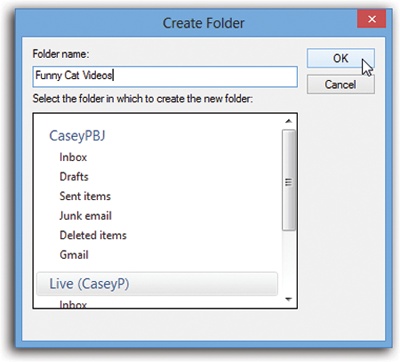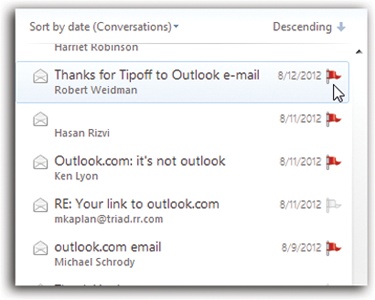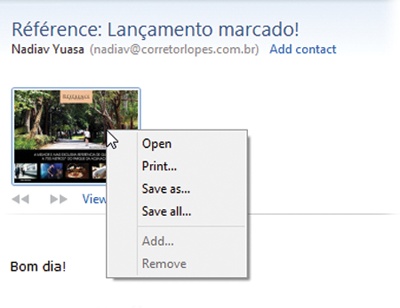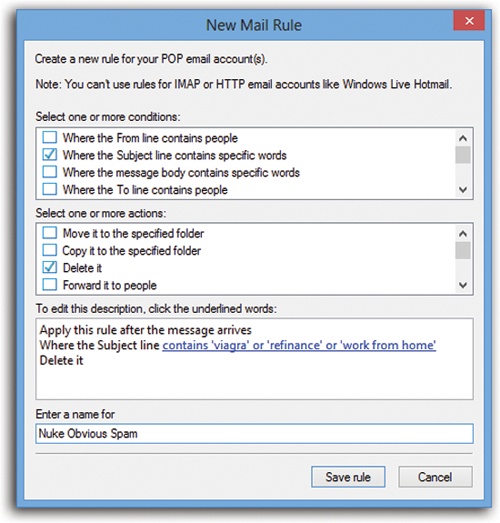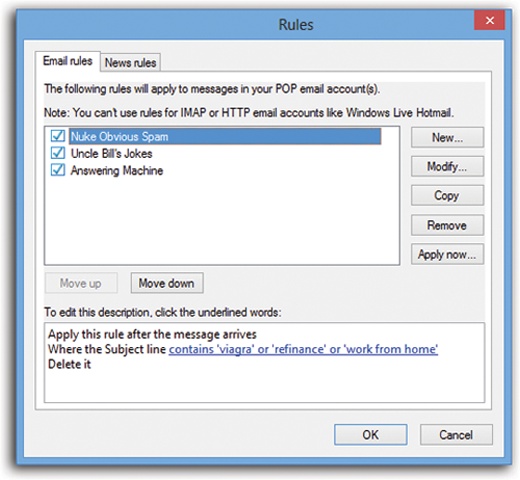Once you’ve read a message and savored the feeling of awe brought on by the miracle of instantaneous electronic communication, you can handle the message in any of several ways.
Sometimes it’s junk mail, sometimes you’re just done with it; either way, it’s a snap to delete a message. Click the Delete button on the Ribbon’s Home tab, press the Delete key, or hit Ctrl+D. (You can also delete a batch of selected messages simultaneously.)
Tip
Above any message from somebody who’s not in your Contacts, in the yellow bar, there’s a “Delete and block” link. What a great way to slam the door in some idiot’s face! You’ll never hear from this person again.
The messages don’t actually disappear. Instead, they move to the Deleted Items folder for that email account. If you like, click this folder to view a list of the messages you’ve deleted. You can even rescue some simply by dragging them into another folder (even right back into the inbox).
Mail doesn’t truly vaporize messages in the Deleted Items folder until you “empty the trash.” You can empty it in any of several ways:
Right-click the Deleted Items folder. Choose “Empty ‘Deleted Items’ folder” from the shortcut menu.
Click the X button to the right of the Deleted Items folder’s name.
Click a message, or a folder, within the Deleted Items folder list, and then click the Delete button on the Ribbon’s Home tab (or press the Delete key). You’re asked to confirm its permanent deletion.
Set up Mail to delete messages automatically when you quit the program. To do so, choose File→Options→Mail→Advanced. Click the Maintenance button, and then turn on “Empty messages from the ‘Deleted Items’ folder on exit.” Click OK.
To reply to a message, click the Reply button on the Ribbon’s Home tab, or press Ctrl+R. Mail creates a new, outgoing email message, preaddressed to the sender’s return address. (If the message was sent to you and a few other people, and you’d like to reply to all of them at once, click “Reply all” instead.)
To save additional time, Mail pastes the entire original message at the bottom of your reply (either indented, if it’s HTML mail, or marked with the > brackets that serve as Internet quoting marks); that’s to help your correspondent figure out what you’re talking about.
Note
To turn off this feature, choose File→Options→Mail, click the Send tab, and then turn off “Include message in reply.”
Mail even tacks “Re:” (meaning “regarding”) onto the front of the subject line.
Your insertion point appears at the top of the message box. Now, just begin typing your reply. You can also add recipients, remove recipients, edit the subject line or the message, and so on.
Tip
Use the Enter key to create blank lines within the bracketed original message in order to place your own text within it. Using this method, you can splice your own comments into the paragraphs of the original message, replying point by point. The brackets preceding each line of the original message help your correspondent keep straight what’s yours and what’s hers. Also, if you’re using HTML formatting for the message, you can format what you’ve written in bold, italics, underline, or even in another color for easier reading.
Instead of replying to the person who sent you a message, you may sometimes want to forward the message—pass it on—to a third person.
To do so, click Forward on the Ribbon’s Home tab, or press Ctrl+F. A new message opens, looking a lot like the one that appears when you reply. Once again, before forwarding the message, you have the option of editing the subject or the message. (For example, you may wish to precede the original message with a comment of your own, along the lines of, “Frank: I thought you’d be interested in this joke about Congress.”)
All that remains is for you to specify who receives the forwarded message. Just address it as you would any outgoing piece of mail.
Sometimes there’s no substitute for a printout of an email message—an area where Mail shines. Choose File→Print, or press Ctrl+P. The standard Windows Print dialog box pops up so you can specify how many copies you want, what range of pages, and so on. Make your selections, and then click Print.
Mail lets you create new folders in the Folders list; by dragging messages from your inbox onto one of these folder icons, you can file away your messages into appropriate cubbies. You might create one folder for important messages, another for order confirmations from shopping on the Web, still another for friends and family, and so on. In fact, you can even create folders inside these folders, a feature beloved by the hopelessly organized.
To create a new folder, see Figure 16-9.
To move a message (or several at once) into a folder, proceed like this:
Drag it out of the List pane and onto the folder icon. You can use any part of a message’s “row” in the list as a handle. You can also drag messages en masse into a folder after selecting them.
Select a message (or several). On the Ribbon’s Home tab (or Folder tab), click “Move to folder.” In a dialog box, the folder list appears; select the one you want, and then press Enter or click OK.
Right-click a message (or one of several you’ve highlighted). From the shortcut menu, choose “Move to folder.” In a dialog box, the folder list appears; select the one you want, and then press Enter or click OK.
Tip
When you click a  triangle in the Folder list, you see all
folders contained within that folder, exactly like in File
Explorer. You can drag folders inside other folders, nesting them
to create a nice hierarchical folder structure. (To drag a nested
folder back into the list of “main” folders, just drag it to the
Storage Folders icon.)
triangle in the Folder list, you see all
folders contained within that folder, exactly like in File
Explorer. You can drag folders inside other folders, nesting them
to create a nice hierarchical folder structure. (To drag a nested
folder back into the list of “main” folders, just drag it to the
Storage Folders icon.)
You can also drag messages between folders; just drag one from the message list onto the desired folder at the left side of the screen.
This can be a useful trick when you apply it to a message in your outbox. If you decide to postpone sending it, drag it into any other folder. Mail won’t send it until you drag it back into the outbox.
Sometimes, you’ll receive an email message that prompts you to some sort of action, but you may not have the time or the fortitude to face the task at the moment. (“Hi there…it’s me, your accountant. Would you mind rounding up your expenses for 1996 through 2004 and sending me a list by email?”)
Figure 16-10. To flag a message, click in the Flag column. Or, if you want to flag a whole batch of selected messages, select them and then click Flag on the Ribbon’s Home tab.
That’s why Mail lets you flag a message, positioning a small, red flag in the corresponding column next to a message’s name. These little flags are visual indicators that mean whatever you want them to mean. You can bring all flagged messages to the top of the list by choosing “Sort by”→Flag (the pop-up menu above the message list).
To flag a message in this way, see Figure 16-10.
Just as you can attach files to a message, people can send files to you. You know when a message has an attachment because a paper-clip icon appears next to its name in the inbox.
To free an attached file from its message, releasing it to the wilds of your hard drive, use one of the following methods:
Right-click the attachment’s name (in the message), select “Save as” from the shortcut menu, and then specify a folder for the saved file (Figure 16-11).
Figure 16-11. One way to rescue an attachment from an email message is to right-click its name and choose “Save as.” You can also drag an attachment’s icon onto your desktop. Either way, you take the file out of the Mail world and into your standard Windows world, where you can file it, trash it, open it, or manipulate it as you would any file.
Double-click the attachment’s name. After you click Open to confirm the risk (it’s always risky to open an email attachment), it opens right up in Word, Excel, or whatever.
Drag the attachment’s icon out of the message window and onto any visible portion of your desktop.
Once you know how to create folders, the next step in managing your email is to set up message rules. These are filters that can file, answer, or delete an incoming message automatically based on its subject, address, or size.
Message rules require you to think like the distant relative of a programmer, but the mental effort can reward you many times over. In fact, message rules can turn Mail into a surprisingly smart and efficient secretary.
Now that you’re thoroughly intrigued about the magic of message rules, here’s how to set one up:
On the Ribbon’s Folders tab, click “Message rules.”
If you’ve never created a message rule, you see what’s shown in Figure 16-12. If you have created message rules before, you see the Message Rules window first (Figure 16-13), in which case you should click New to open the New Mail Rule window shown in Figure 16-12.
Figure 16-12. Building a message rule entails specifying which messages you want Mail to look for—and what to do with them. By adding the underlined words, as shown here, you specify what criteria you’re looking for. Here, any email with the words “Rolex,” “Refinance,” or “Viagra” in the subject line is automatically deleted.
Use the top options to specify how Mail should select messages to process.
For example, if you’d like Mail to watch out for messages from a particular person, you would choose, “Where the From line contains people.”
To flag messages containing “loan,” “$$$$,” “XXX,” “!!!!,” and so on (favorites of spammers), choose, “Where the Subject line contains specific words.”
If you turn on more than one checkbox, you can set up another condition for your message rule. For example, you can set up the first criterion to find messages from your uncle, and a second that watches for subject lines that contain “joke.” If you click the Options button, you get to specify whether the message has to contain all the words you’ve specified, or any of them.
Using the second set of checkboxes, specify what you want to happen to messages that match the criteria.
If, in step 2, you told your rule to watch for messages from your uncle containing the word “joke” somewhere in the message body, here’s where you can tell Mail to delete or move the message into, say, a Spam folder.
With a little imagination, you’ll see how these checkboxes can perform absolutely amazing functions with your incoming email. Windows Live Mail can delete, move, or print messages; forward or redirect them to somebody; automatically reply to certain messages; and even avoid downloading files bigger than a certain number of kilobytes (ideal for laptop lovers on slow hotel room connections).
Specify which words or people you want the message rule to watch out for.
In the bottom of the dialog box, you can click any of the underlined phrases to specify which people, which specific words, which file sizes you want Mail to watch out for—a person’s name, or “Viagra,” in the previous examples.
If you click “contains people,” for example, a dialog box appears that lets you open your Contacts list to select certain individuals whose messages you want handled by this rule. If you click “contains specific words,” you can type in the words you want a certain rule to watch out for. And so on.
In the very bottom text box, name your mail rule. Click OK.
Now the Message Rules dialog box appears (Figure 16-13).
Tip
Windows Live Mail applies rules as they appear—from top to bottom—in the Message Rules window. If a rule doesn’t seem to be working properly, it may be that an earlier rule is intercepting and processing the message before the “broken” rule even sees it. To fix this, try moving the rule up or down in the list by selecting it and then clicking the Move Up or Move Down buttons.
You can use message rules for many different purposes. But here are two of the best:
File mail from specific people. For instance, if you have a few friends who constantly forward their idea of funny messages, create a rule that sends any email from them to a specific folder automatically. At the end of the day, look through the folder just to make sure you haven’t missed anything and, if you have time, read the “most excellent funny emails in the whole wide world.”
The email answering machine. If you’re going on vacation, turn on “For all messages” in step 2, and then “Reply with message” in step 3. In other words, you can turn Windows Live Mail into an email answering machine that automatically sends a canned “I’m away until the 15th” message to everyone who writes you.
